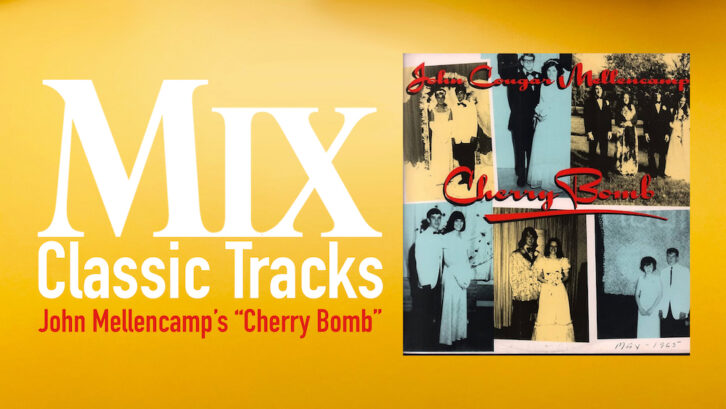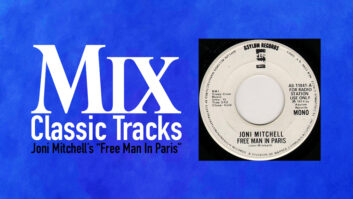
The recording of The Lonesome Jubilee in September 1986 marked engineer David Leonard’s first of eight projects with John Cougar Mellencamp, and it coincided with the initial directional change for the artist, shifting from guitar-based rock ‘n’ roll to a roots Americana collection of stringed instruments that have since become his standard.
A large group of musicians—Kenny Aronoff, drums and percussion; Larry Crane, guitars, mandolin, harmonica, autoharp, banjo, backing vocals; John Cascella, accordion, keyboards, saxophone, melodica, pennywhistle, claves; Lisa Germano, fiddle; Toby Myers, bass guitar, banjo, backing vocals; Pat Peterson, backing vocals, cowbell, tambourine; Crystal Taliefero, backing vocals; and Mike Wanchic, guitars, dobro, banjo, dulcimer, backing vocals—joined Mellencamp just outside of Bloomington, Indiana, at his picturesque Belmont Mall Studios. Leonard remembers it with a big window looking out onto a horse field.
At the time, the studio was equipped with a Trident 80B console, known for its “rock ‘n’ roll sound;” Otari-MTR 90 2-inch tape machine (which it still has); Ampex ATR 1/2-inch and Otari 1/4-inch decks; Fostex four-way speakers in the wall and Yamaha NS-10s up close for monitoring; Fairchild and LA-2A compressors; Neve mic preamps; API EQs and various other pieces of outboard gear.
Mellencamp would typically bring in lyrics and maybe a cassette of him playing chords and singing lyrics. From there, as Leonard recounts, “We just made it up as we went along to find a sound that John was hearing. “Traditionally, we would all go in the control room and somebody would play guitar and John would sing, or John would play guitar and sing and Kenny would have a conga or bongo, and everybody would just work out the arrangement sitting around listening to each other—working out intro-verse-chorus, intro-verse-chorus—and what the hook was going to be for the whole form of the song, and then we would go out on the floor and play it all together,” Leonard adds. “John’s a great arranger with his band and with those instruments. He knows what he wants, and he and Don (Gehman, producer) would bounce stuff off each other all the time.”
Drums, bass, guitars, accordion, violin and vocals were recorded live. There were some punch-ins and add-ins, but for the most part, “Cherry Bomb” and the other tracks on The Lonesome Jubilee were recorded live.
“We set up everybody on the floor and everybody plays together, and that’s how it’s done in Indiana,” Leonard says with a laugh, adding that Mellencamp always sang live, though he “probably recorded another couple of vocal tracks that could be comped. He liked to be on the floor with the band with headphones on, singing and calling out the shots.”
Drummer Kenny Aronoff notes that even if Mellencamp re-did his vocals, he would only do a few passes. “John wanted to get a whole song done in one day,” Aronoff says. “He wanted to get all overdubs and everything finished in one day. He wanted to know immediately, ‘What do we have here?’”
The extra vocals on the second verse of “Cherry Bomb,” provided by Taliefero, Myers and Wanchic, were overdubbed, as was the autoharp in the third verse. Leonard concedes that recording the autoharp can be a little tricky, as it has a lot of mechanical noise due to the bars and the mute.
MIKING ARONOFF’S KIT
“That whole record/song was different for Kenny because he usually had a very high snare sound, and [“Cherry Bomb”] was a deeper snare than usual,” Leonard says. “That room is a very, very live drum room. It’s got like a black composite rubber floor, and it’s all drywall with a vaulted ceiling.”
Aronoff gives kudos to Mellencamp for bringing his drumming to the foreground, both sonically and in general. By mere virtue of the artist wanting the drums loud in the mix from day one on “Jack and Diane,” Aronoff garnered lots of attention throughout the musical community.
Back in 1987, Aronoff was using the same 5×14-inch Ludwig Acrolite snare drum on The Lonesome Jubilee that Gehman had provided on its predecessor, Scarecrow. He assumes to this day that it was Mellencamp’s decision to detune it on Jubilee.
As for the mics on Aronoff’s kit, Leonard admits that it was a while ago, but recalls a Shure SM57 on the snare, or possibly an AKG 451, or perhaps a combo. He used an E-V RE20 on the bass drum, and Sennheiser 421s on the toms, with Neumann U67s as the overheads.
While working to get the snare sounds, Leonard says that he and Gehman came up with their own vernacular for communication and expediency, assigning nicknames to describe different frequencies—like the “boing, crunch, crack or knock” sounds.
“When you work with people enough, you can have a name for it,” Leonard says.
VOCALS AND GUITAR
Mellencamp sang into a U67. According to Leonard, his vocal chain has forever been the Neumann mic into a Tube-Tech mic pre, then into an LA-2A.
He says they probably used SM57s on the guitars, which went through Neve preamps and/or the preamps in the Trident 80B; the monitor panel handled playback of the 2-inch tape machine.
“Most of the tracking went through that 80B for those mic pres,” Leonard says, “because we only had maybe half a dozen outboard mic pres—maybe two Neves, a couple of APIs and the two Tube-Techs.”
On Germano’s fiddle, they “probably used a U47 or C-12,” and on Cascella’s accordion, “most likely the C-12 if Lisa was on the 47.”
Leonard can recall it being a packed house with background singers in the hallway and musicians in the lounge, sometimes as many as nine at a time, with drums, accordion, two guitars, Mellencamp, violin, Crystal and more.
When asked about the studio vibe, Leonard laughs. “Well, there were a lot of cigarettes, so a lot of smoke. John’s rule was he liked to have everybody in the control room if there was music being made; nobody in the lounge, everybody accounted for. The vibe was very creative. I think they knew they were on to something. It was a big change in his sound.”
Leonard confides that they did not all adapt to that change immediately.
CREATING A NEW SOUND
“The whole sonic landscape of that album was all very acoustic and organic and in the room and live, and that was something that took a minute to find,” Leonard says. “It’s always a challenge to find what other people are hearing in their head.”
Sometimes Mellencamp would suggest that Leonard listen to a particular song by another artist for reference to a sound he wanted, perhaps in the way a guitar or track might have been treated.
“John has a very wide range of influences,” Leonard says. “He listens to a lot of music, so he’ll pull up stuff, and that’s the challenge—to hear what’s in that track that could relate to what you’re doing or what you’re trying to do. That’s always fun to see how somebody else treated this or that. Sometimes the drums are not as loud as you think they are. Talking about music is hard.”
Classic Tracks: Jimmy Buffett’s “Margaritaville”
“Cherry Bomb” was not particularly challenging, Leonard adds, because it is not an aggressive song. “The more aggressive the song, the harder it is, because there is more competition for the space,” he explains. “On The Lonesome Jubilee, a song like ‘Paper in Fire’ would have been more challenging because it was more bombastic. ‘Cherry Bomb’ was a lot more relaxed of a song, more R&B, so it wasn’t as challenging in a sonic way. The only challenges would have been the choreography of the finger snaps, doing the reverb on the snaps in the breakdown to make it have the texture.”
He then admits that the mix was the “hard part.”
“Everything is fun and games until you have to mix,” he laughs. “That’s when you have to commit. The challenge there was giving John a cassette at the end of the night to take home, and then he’d come in in the morning and if he didn’t like it, you could tell right away.”
Because the artist was trying to define a new direction, it complicated the situation. They would go up to Mellencamp’s house and he would reference artists that didn’t necessarily make sense in the musical context, Leonard remembers; the comparison was that they were forging their own directions.
In the end, obviously, it all worked out. The album charted high in 10 countries, going to No. 6 on Billboard’s Top 200, with “Cherry Bomb” hitting No. 1 on the Mainstream Rock Chart. The record received many accolades.
Aronoff, in particular, says he appreciated the new direction of the album.
“I loved that we came up with something unique,” he says. “I knew it was unique because it was still a powerful rock band with a lot of great, radio-friendly songs that kept the same balls and energy. I always wanted energy—and on that Jubilee record, we did keep that energy up, but we added these new sounds, and I recognized that that was cool. John was always looking for new ideas, and to see him excited was really cool because it made the room really upbeat. When the boss is down, you have to work hard to keep yourself up, but when the boss is up, you feel up!”







